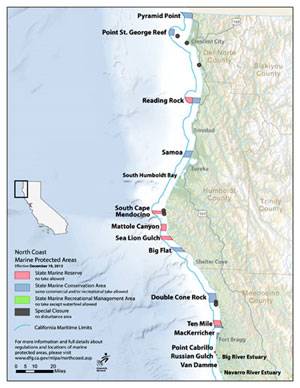by Rona Fried
Thanks to strict quotas, an ecosystem approach and sanctuaries, there’s actually good news for ocean ecosystems surrounding the US – many species of fish are bouncing back.
After being severely depleted for decades, 40 species are classified as "over-fished," down from 98 in 1999. Even better, 34 species have recovered to the point where they can support maximum sustainable yields, including King Salmon and South Atlantic black sea bass, says NOAA in its annual update.
Commercial fishermen are benefiting from the discipline, hauling their biggest catch in more than a decade in the past several years.
New England, the Gulf of Mexico, and the South Atlantic are still struggling to rebuild certain fish stocks, but California and the Pacific Northwest have seen amazing changes – and just since 2011.
The Monterey Bay Aquarium Seafood Watch program now lists 21 species as "sustainable" instead of "avoid," an unprecedented turnaround, they say.
And that’s after the government called those fishing grounds an economic disaster in 2000. 84% of commercial groundfish caught off the West Coast are considered sustainable, such as Dover and English sole.
Marine preserves in Northern California:

"Fishermen are using innovative ways to avoid catching overfished species and protect the marine habitat. Because of incentives inherent in the catch share program, bycatch and discards are plummeting. Fishermen are sharing information with one another about where overfished species are congregating so they can be avoided. Many fishermen have even entered into joint agreements to voluntarily stop fishing in certain areas," says Environmental Defense Fund, which led the program.
Bycatch is still a huge problem, however, with "hundreds of thousands of dolphins, whales, sharks, sea birds, sea turtles and fish needlessly dying each year because of indiscriminate fishing gear," says Amanda Keledjian, a marine scientist with Oceana. It’s amazing that trawling is still allowed and nets with thousands of baited hooks up to two miles long.
But overall, there’s also good news worldwide – 70% of fisheries are within biologically sustainable limits, says the UN Food and Agriculture Organization (FAO). The reversal has also happened in just a few years. But most are still fished to those limits and that has to change.
That’s where Global Fishing Watch comes in, where satellites will be used to bring commercial fishing into sharp relief.
Read our articles, EU Finally Moves To Sustainable Fisheries and How Community Fisheries Save Fish and Local Economies.
Not So Good For Tuna, Sharks
But tuna is another story. I stopped eating tuna sushi (maguro) years ago when I learned the population was decimated.
Hunted to just 4% of its population, 90% of the Bluefin tuna catch are juveniles – too young to have spawned – and the few adults are aging and won’t reproduce much longer, according to the International Scientific Committee for Tuna and Tuna-like Species in the North Pacific Ocean.
Still, the International Commission for the Conservation of Atlantic Tunas raised the quota 20% for each of the next two years, after noticing a small recovery. Turkey says it will violate even that agreement, catching up to 73% more.
In the Pacific Ocean, the Western and Central Pacific Fisheries Commission oversees the tuna catch. This year, they finally agreed to a quota – the catch for adults is the average of 2002-2004, and half that for juveniles. They also set a pathetic 10-year goal of rebuilding the population to 8% of its historical size – without a plan.
"What makes this story different than the dramatic decline of Atlantic cod or even Atlantic Bluefin tuna is the ability to change the trajectory of Pacific bluefin population in a short time. In just a few years this recovery process could be a case study in how political leadership and commitment from industry can transform even the most depleted fishery. It’s time for Japan, Mexico and the US to step up," says Amanda Nickson, Director of Global Tuna Conservation for Pew Charitable Trusts.
"Bigeye tuna [also used for sushi, down to 16% of its historic population] are extremely overfished, albacore fisheries are no longer profitable, and yellowfin and even skipjack tuna are starting to buckle under the strain of a fishery out of control," says Lagi Toribau of Greenpeace Australia Pacific.
Sharks are also in trouble and the Commission failed to adopt proposals that would have clamped down on shark finning.
Sharks Get Protection
Luckily, there is some good news for sharks.
Micronesia, in the Western Pacific, is creating a shark sanctuary the size of India, taking up its entire ocean economic zone – 1.1 million square miles. Commercial fishing and sale of sharks and rays and their parts are prohibited.
As important as "corridors" are on land that allow animals to migrate without being hunted, Micronesia is doing the same for sharks and other marine species. Its move completes the Micronesia Regional Shark Sanctuary, which already includes the waters of Palau, Marshall Islands, Guam and Northern Marianas Islands. There are now 10 shark sanctuaries in the world’s oceans.
An estimated 100 million sharks are killed each year, threatening a third of shark species with extinction. As top predators, sharks regulate the ocean’s food web and are critical to maintaining healthy habitats like coral reefs.
Last year, President Obama created the largest marine sanctuary in the world in the Pacific.
The Global Oceans Commission has an 8-step rescue package for oceans, including: cap subsidies for commercial fishing (which encourage bottom trawling); create more marine sanctuaries; and limit oil and gas exploration.
Read From Decline to Recovery, A Rescue Package for the Global Ocean:

Considering the effects of fukushima since 2011, I find this hard to believe.